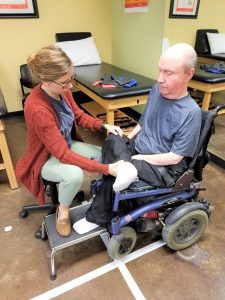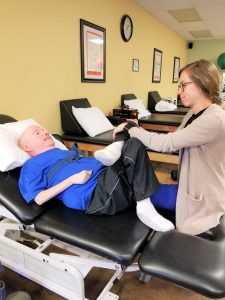Improvements in Range of Motion with Physical Therapy

A frequent complaint and limitation for patients that have been diagnosed with SMA is lack of flexibility throughout their body. Contractures, or shortening of muscles leading to deformity of joints, can occur secondary to lack of ability to perform active range of motion and being in a seated position for a prolonged period when in a wheelchair. This can be very uncomfortable as well as lead to the inability to perform functional tasks secondary to lack of range of motion. Michael has severe contractions in different parts of his body from years of being in a seated position for prolonged periods, which has been one focus of our therapy over the past three years.
When Michael first began physical therapy, he was lacking approximately forty-five degrees of knee extension, meaning he was forty-five degrees from his knees being fully straight. We have worked on this weekly with him on and off the therapy table. We have worked on improving his knee extension by stretching out his hamstrings both proximally, meaning the insertion closest to his trunk, and distally, meaning the insertion farther down his leg. We’ve worked on stretching out the muscles in every way we can, as well as performing aggressive mobilizations of his knee joint to help improve his mobility. Michael now exhibits about a twenty-degree bend at the end range of knee extension, which is a vast improvement. More importantly than the objective measurements, Michael now has less pain in his legs and hips and has improved his ability to perform activities such as prolonged sitting and lying in different positions.
With the inability to build muscle currently, due to the SMA disease, we have been focusing on core stability and control along with the flexibility to prepare for upcoming treatments that will attempt to target the ability to build muscle. Increasing the range of motion of these joints, such as the knees and hips, will allow for a larger range to build strength in, therefore, improving his ability to use lower extremities for functional tasks such as dressing and transferring. Once the time comes to begin focusing on strength, we will continue to perform stretches to make sure he maintains his increased range of motion, especially with him being in a seated position for the majority of each day.
Flexibility is important in treating many different diagnoses, not simply neurological patients. Having full motion of each joint and muscle attachment leads to the ability for the body to perform as a whole and to its full potential. It is important to assess each patient and note where improvements can be made and make a plan to improve those movements.
======================== Patient Perspective ========================

When I started physical therapy in October 2017, I was shocked and horrified at the amount of atrophy that had found its home in my body. When I was a child, I could sit on the floor and wrap my legs over my head, and the amount of flexibility that I had was endless. As I aged, this flexibility became a thing of the past, but it wasn’t until I started physical therapy, that I realized just how much damage SMA had done to my body.


I’ve been extremely fortunate to have had the ability to work with 2 outstanding physical therapists. One of my main goals in physical therapy is to remain as limber and flexible as possible. With the potential of an upcoming muscle-targeted therapy on the horizon, not only will I have the ability to work on flexibility and range of motion, we will also have the ability to start building muscle mass and muscle strength. The more flexible I am, the more muscle we will be able to target during my therapy sessions.
If you’re a physical therapist working with SMA patients, strive to get them as flexible as possible, remembering that flexibility and range of motion will not only help them to sit for prolonged periods in their wheelchair, it will also increase their quality of life.

